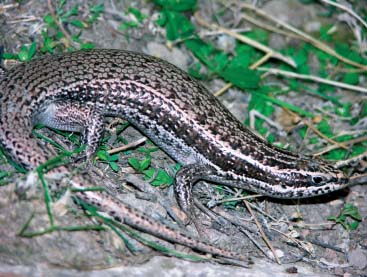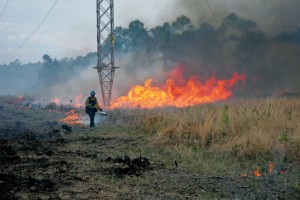Golden grass mabuya: Red Data Book of Armenia

Skinks — Scincidae
Status. Listed in the IUCN Red List of Threatened Species (ver. 3.1) as Data Deficient DD. According to IUCN criteria categorized as Vulnerable VU B1ab(iii)+2ab(iii).
Distribution. Distributed in Northeastern Saudi Arabia, Southern Iran, Iraq, Bahrain, Northern Oman, Erithrea, Turkmenistan and the South Caucasus. The northern boundary of the global range extends over Armenia, Azerbaijan and Turkmenistan.
Distribution in Armenia. Recorded in the vicinities of Yerevan, Eghegnadzor, Ararat, Meghri, Areni, Agarak, Lehvaz, Vedi, Astazur, Asni and Jrvezh, as well as on the Urts Ridge.
Habitats. Steep slopes of mountains and foothills at 500–1400 m above sea level covered with sparse arid vegetation with an essential presence of rocky outcrops, boulders and fractures. Sometimes mabuyas occur in gardens, abandoned buildings and ruins. Rock crevices, hollow spaces between stones and, sometimes, rodent burrows are used as hideouts.
Biological traits. Comes outwards after hibernation in late March. Feeds on different invertebrates. Mating occurs in early to mid–May. Three to eight offspring are born in July.
Population size and its trends. Size and density of populations are unstable and fluctuating in years. The biggest populations live in the country’s south near Meghri, Agarak and Nrnadzor. Warm winters ensure stability and less prominent fluctuations of local populations. The population density in arid habitats does not exceed 8 individuals/ha. In most sites the lizard population is decreasing. Somewhere it is extremely rare and in the Ararat Valley it is virtually extinct.
Major threats. Habitat encroachment for agricultural production, habitat loss, overgrazing in foothill areas, changes in spring water regime and poaching.
Conservation measures. Protected in Khosrov Forest Reserve, Goravan Sands Sanctuary and Arevik National Park. It is essential to strengthen control over poaching.
Suggestions
 Flora and fauna suffer as a result of burning of grass plots
Flora and fauna suffer as a result of burning of grass plots
 The Ministry of Environment sent a letter international partners to draw their attention to the real danger of environmental disasters as a result of Azerbaijan's large-scale aggression towards the territory of Armenia
The Ministry of Environment sent a letter international partners to draw their attention to the real danger of environmental disasters as a result of Azerbaijan's large-scale aggression towards the territory of Armenia
 Vicia pisiformis: Red Data Book of Armenia
Vicia pisiformis: Red Data Book of Armenia
 Vavilovia formosa: Red Data Book of Armenia
Vavilovia formosa: Red Data Book of Armenia
 Trigonella capitata: Red Data Book of Armenia
Trigonella capitata: Red Data Book of Armenia












